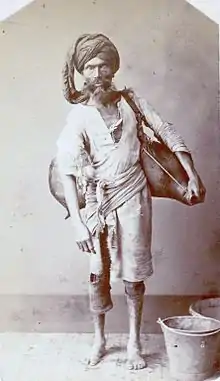Water carrier
Water carrier (also water seller) is a profession that existed before the advent of centralized water supply systems.[1] A water carrier collected water from a source (a river, a well, water pumps, etc.) and transported or carried containers with water to people's homes. After the construction of pipe networks, the profession of water carrier became unnecessary and disappeared.[2]

A water carrier or “bhisti” in India,
In late Qing dynasty Chengdu, there were over one thousand people who worked as water carriers. They didn't just perform their official duties, but also helped the elderly and sick who could not take care of themselves with housework. In the 1940s Chengdu water carriers still went barefoot to show that they go deep into the river to collect the purest water.[3]
Gallery
 Tunisia, early 20th Century
Tunisia, early 20th Century Water Carriers Of The Ganges river, early 20th Century
Water Carriers Of The Ganges river, early 20th Century Rajasthan in 2006
Rajasthan in 2006 Venice, 19th Century
Venice, 19th Century Water Carrier on the Banks of the Nile river, early 20th Century
Water Carrier on the Banks of the Nile river, early 20th Century The Water Carrier, by Eugene de Blaas, early 20th Century
The Water Carrier, by Eugene de Blaas, early 20th Century Statue of a water carrier with a pikolan (yoke), China
Statue of a water carrier with a pikolan (yoke), China El Aguador (The Water Carrier) by Emiliano G. Hernández. Avenida de Juan de Bethencourt and Calle Leon Y Castillo in Puerto del Rosario, Fuerteventura, Canary Islands
El Aguador (The Water Carrier) by Emiliano G. Hernández. Avenida de Juan de Bethencourt and Calle Leon Y Castillo in Puerto del Rosario, Fuerteventura, Canary Islands By Eugen de Blaas, early 20th Century
By Eugen de Blaas, early 20th Century (Vodonoska), the Water Carrier. Russian Dymkovo painted figurine in clay
(Vodonoska), the Water Carrier. Russian Dymkovo painted figurine in clay
See also
- Aquarius (astrology)
- Habibullah Kalakani, known as Son of the water carrier.
- Les deux journées, an 1800 opera by Luigi Cherubini also known as The Water Carrier.
References
| Wikimedia Commons has media related to Water carriers. |
- R.R. Rakimov, Музей антропологии и этнографии им. Петра Великого (Кунсткамера) (2009). Центральная Азия: традиция в условиях перемен. Центральная Азия: традиция в условиях перемен. v. 2. Nauka. p. 365.
- A.N. Angelakis, L.W. Mays, D. Koutsoyiannis (2012). Evolution of Water Supply Through the Millennia. IWA Publishing. p. 209. ISBN 9781843395409.CS1 maint: multiple names: authors list (link)
- Di Wang (2003). Street Culture in Chengdu: Public Space, Urban Commoners, and Local Politics, 1870-1930. Stanford University Press. pp. 75–76. ISBN 9780804747783.
This article is issued from Wikipedia. The text is licensed under Creative Commons - Attribution - Sharealike. Additional terms may apply for the media files.